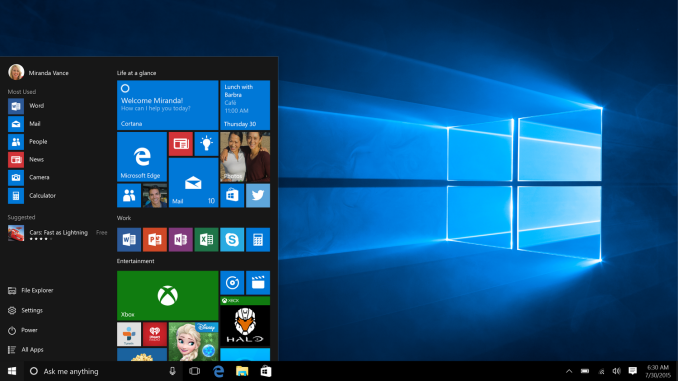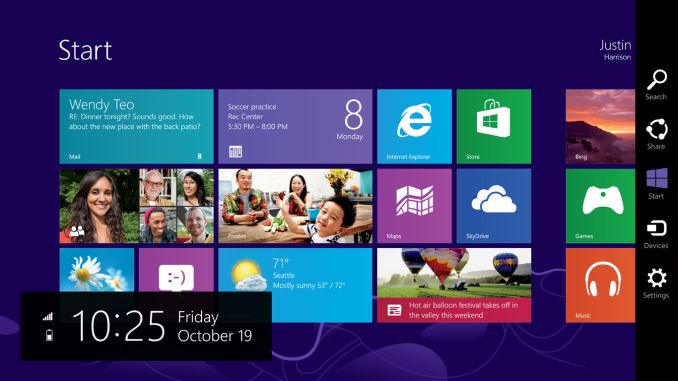The Windows 10 Review: The Old & New Face of Windows
by Brett Howse on August 25, 2015 8:00 AM EST- Posted in
- Operating Systems
- Microsoft
- Windows 10

Let’s flash back to 2012. About three years ago, Windows 8, the last major release of Microsoft’s ubiquitous operating system, was released to manufacturers. This was to be Microsoft’s most ambitious release yet. Traditional PC sales were in decline, and more personal devices such as the iPad tablet were poised to end the dominant PC platform. Microsoft’s response to this was to change Windows more than in any previous release, in a bid to make it usable with the tablet form factor. Windows 8 launched in October 2012 to much fanfare.
There was much fanfare, but little in the way of sales. Yes, Microsoft did sell many copies of Windows 8, but it did not help the declining PC market rebound. Windows 8 came to be with a touch first interface, with a new Start Screen replacing the traditional Start Menu, and a new breed of Windows 8 apps, which run on the WinRT framework. These WinRT apps have been named many things over the past three years, starting with Metro apps. A trademark dispute ended that naming scheme though, and over time they have morphed from full screen apps to universal apps to Windows Store apps, and practically none of them were able to rival the older Win32 platform in popularity or productivity.
Windows 8 did bring some great features to Windows, but they were overshadowed by the major design shift which, while good as a touch based operating system, alienated many who still used Windows on a traditional desktop or notebook. The Start Screen was a big turn off to many people, and full screen apps were not very efficient on a large screen display. Even the multitasking in Windows 8 was less than ideal, with the initial release only allowing two Windows Store apps to be open at any one time, and the second was relegated to a small side bar.
Microsoft’s own faith in Windows 8 was clearly not strong. Only a couple of weeks after Windows 8 launched, they unceremoniously dumped the project head Steven Sinofsky from the company, and spent the next two years trying to make Windows 8 more usable on traditional mouse and keyboard type machines, which were the vast majority of Windows devices in the hands of users. Windows 8.1 arrived and fixed some of the key issues with Windows 8, and 8.1 Update launched with the ability to boot to the desktop, and avoid the touch interface almost completely if you wanted to.
 Windows 10 Start Menu and Desktop view
Windows 10 Start Menu and Desktop view
When looking at Windows 10, I think it is pretty important to look back over the last three years, because none of this is ever built or designed in a vacuum. Microsoft has a huge number of devices running Windows, but a large majority of them are running Windows 7, which was an evolutionary desktop upgrade. Windows 8 struggled to ever take over any of that usage share. Windows 10 is Microsoft’s attempt to bridge the divide. Windows 7 is used by hundreds of millions of people, but its touch support is practically zero. Windows 8 works well in a touch scenario, but is not ideal for keyboard and mouse based devices. Windows 10 promises to be the version of Windows which bridges this gap.
Windows 10 brings about as much change as Windows 8 did, but in almost all cases it is going to be appreciated by users rather than avoided. It will run on a dizzying number of device types, including the traditional desktop, notebook, tablet, two-in-one, phone, IoT, Raspberry Pi, Hololens, Surface Hub, and even Xbox One. What it will bring to each of those device types is not the single interface that Windows 8 pushed on the desktop, but a unified app platform. Each device type will have its own interface, but the underlying app platform will allow developers to target a huge number of devices. And developer buy-in is the one thing Microsoft needs more than any other in order to make this vision succeed. For all of Windows 8’s quirks, it was really the lack of quality apps in the Windows Store which was the one hurdle Microsoft could not code around. Only time will tell whether or not the new model succeeds where the old one failed, but at the beginning of the life of Windows 10 we can go through all aspects of it and see what’s new, what’s changed, and how it fits in on today’s devices.











293 Comments
View All Comments
splashd - Tuesday, August 25, 2015 - link
I love Windows 10 as a laptop OS. I looked forward to the promise of the 2-in-1. The lack of a swipe-able keyboard in tablet mode makes it non-competitive for applications that are primarily tablet-oriented. The tablet keyboard is horrible.Cerif27 - Tuesday, August 25, 2015 - link
When you guys get Cortana could you update? I have a Realsense camera (the same one you have) and I have had a heck of a time getting "Hey Cortana" to work consistently. Even pressing the mic icon gives me trouble sometimes. I've had no other trouble with it (except placement at my desk) so your input and thoughts would be appreciated.yankeeDDL - Tuesday, August 25, 2015 - link
I have upgraded to Windows 10 only for a few days, so mine are just the first impressions, however, the new Start Menu is still a massive disappointment.Quite frankly, for me, finding “anything” in the new menu, takes ages compared to the Windows-7 (or even Windows XP) style Start Menu.
It may be subjective, but I see very little value added in the live tabs (new Xbox games! Yeah! Wait a minute, I don’t own an Xbox, why in the world would I care?): if I want news, I look at news, I don’t go to my Start Menu.
I suppose it’s me.
Anyway, as in Windows8, it got already replaced by the “Classic Start”. A pity, really, that to get improved performance and DirectX 12, I cannot stick to Windows 7, but I have to jump 3 (no less!) generations of Windows. I see the commercial needs of Microsoft but, hey, if you give it to me “for free”, why can’t you just update my Windows 7 instead? I liked it just fine …
And, boy, if you are thinking about doing a fresh install instead, for the love of God, think again. “Nightmare”, doesn’t even begin to cut it.
nightbringer57 - Tuesday, August 25, 2015 - link
Well to be honest even windows 8 didn't change anything for me on the start menu issue.Just out of curiosity, is there any reason you would research things in the start menu manually?
It's been years since I started pressing windows key, typing a few letter and finding what I wanted immediately.
I had to use the windows XP style menu for a few months at work, and for me, it was a real pain in the ass, going back to this from windows 7/8 search (the 8 one has its flaws as well)
Mr Perfect - Tuesday, August 25, 2015 - link
The menu is helpful when finding programs that you don't remember the name of, but recognize on sight. Whether it's something you only use once a month, or a brand new program you haven't memorized yet, you can't do a search for "The one with the pick axe icon" or "that expense report generator".yankeeDDL - Tuesday, August 25, 2015 - link
I use a lot the pinning function in Windows7, and have a lot of frequently used programs pinned both in teh start menu and in the taskbar. These cover 90% of the programs I use daily, which means I don't need to take my hands off the mouse to type, which is beneficial.In Windows8/10 pinning what I use goes below stuff I don't need (unless there's a way to bring it up, which I have not figured out). Still, there's just "too much stuff" in the Start menu now, and the majority of it, I don't use at all, so it bothers me that it is there.
The remaining 10%, I used to find rather quickly as I managed my Start Menu with groups (folders). I used the search too, of course, but I appreciated the small, but clearly defined search window on Windows 7 menu. In windows 10 there's a gigantic search bar in the taskbar (removed instantly) and the Start Menu is searchable, but you have to start typing and, for example, it doesn't seem to show the previous searches, like Windows 7 did, which was also handy ...
All in all, as I said, disappointing. It does not add any feature I need, and it removes, or somewhat complicates features I really liked and used.
No biggie, because I go back to Classic Start (as I HAD to do in Windows 8/8.1), but still, feels like a missed opportunity.
tonytroubleshooter - Wednesday, August 26, 2015 - link
the Start button, right-click options are welcomed, but.... that is all....nightbringer57 - Tuesday, August 25, 2015 - link
And, by the way (no edit), that's not 3 generations of windows, you're only jumping over one to get to the second one.yankeeDDL - Tuesday, August 25, 2015 - link
Yes, I do use it often as well, but not always.I do have a relatively large of SW installed (in many cases, various versions of the same), and having folders sometimes helps. The rest is habit.
I don’t claim that this is the way it should be, but, frankly, I have no use for the live tiles and Windows 7 menu seemed much cleaner and effective to me. Not perfect, but not too bad either.
Windows 8 was preposterous. Windows 10 is better, but if I had to choose between the two, I’d still go for Windows 7.
Flash13 - Tuesday, August 25, 2015 - link
Windows 10 is still not ready for prime time. It's not bad, but that doesn't make it really good! Anyone on Anandtech staff on MS payroll?